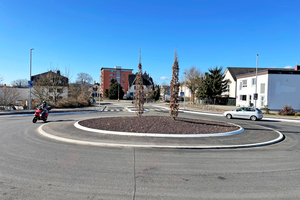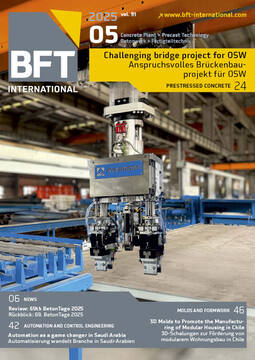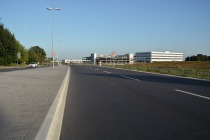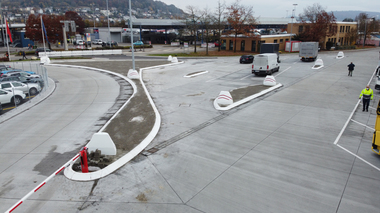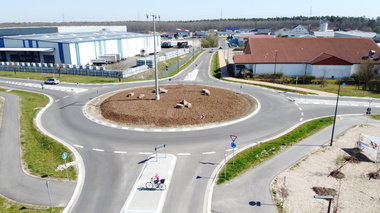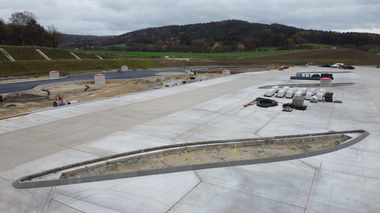Traffic roundabout in Geisenheim implemented with curbstone adhesive bonding techniques
For new or rebuilt intersections, planners often decide for traffic roundabouts to cope more effectively with increasing traffic in our towns and cities. Roundabouts, as a rule, facilitate the flow of traffic and lead to fewer points of conflicts than do signal-controlled intersections. These benefits arise from eliminating the frequent cause of traffic accidents when drivers turn left while crossing oncoming traffic. The slower speeds of vehicles upon entering a roundabout also reduce severe accidents. Other benefits result from reduction of CO2 emissions from less fuel consumption due to decreased stop-and-go traffic. Roundabouts, furthermore, are regarded as having a longer service life and as requiring less maintenance compared to signal-controlled traffic hubs. Well-designed roundabouts, not least, are often more visually attractive than traffic lights. When building roundabouts at traffic hubs, the question that repeatedly arises is the most suitable construction methods for the roundabout and the relevant traffic control systems. Because conventional installation of curbstones is a very complex and expensive as well as time-intensive solution, planners are increasingly choosing curbstone adhesive bonding techniques for traffic control systems. A good example of this is the reconstruction of a T-crossing in Geisenheim in the Rheingau-Taunus district in Germany.
The intersection of Chauvignystrasse and Industriestrasse is a central traffic hub in the eastern area of the city on the Rhine. Here, Industriestrasse – classified as a rural road L3272, coming from the districts Stephanshausen, Marienthal and Johannisberg – meets Chauvignystrasse, which in the supra-regional traffic network is classified as Federal Highway B42a. Those responsible have long observed an increase in traffic in this area. Particularly during traffic peaks in the morning and evening, waiting times occur as well as considerable tailback lengths for traffic turning toward Johannisberg. Since this situation – due to expansion of an industrial estate in the north – will further deteriorate, an agreement was reached with the responsible public authority Hessen Mobil to perform a capacity calculation with the objective of minimizing tailback lengths during traffic peaks.
Minimizing tailback lengths during traffic peaks
Two varieties were investigated for reorganization of this traffic hub. First, to rebuild it as a traffic roundabout or, second, to provide a light signal system. Reorganization as traffic roundabout would result in quality level A during peak traffic hours in the morning and B in the afternoon, with the result that the traffic hub could be classified as efficient. With a light signal system, the traffic hub would reach quality level C during peak traffic hours in the morning and level D in the afternoon so that the traffic hub would also be classified as efficient. However, waiting times of up to 57 seconds, especially during traffic peaks in the afternoon, would be excessive and considerably longer than would be the case with reorganization as traffic roundabout. Furthermore, tailback lengths of up to 200 m – calculated with a certainty of 95% against excessive tailback – would partially lead to massive impairments at access and exit points at the bordering commercial developments and would therefore be unacceptable. The final decision was for reorganization of the traffic hub to form a roundabout.
Tight time-frame for restructuring the traffic hub
Dipl.-Ing. (FH) Bertil Mensebach of the engineering consultancy of the same name in Rheinböllen, explains the measure: “The planned traffic roundabout has a diameter of 30 m. The access roads of the four connection arms have roadway widths of 3.75 m, with exit widths of 4.75 m each. Entrances and exits are separated by a lane divider 3 m wide. The time frame for restructuring the traffic hub – only 8 weeks – was extremely tight. The aim – owing to the supra-regional bus connection and the limited bypass possibilities toward Wiesbaden – was to carry out the extension as far as possible with blockage of only one lane, primarily during the summer vacation.
Only the installation of the binders and the bearing courses would require complete road blockage. “For this reason, we decided for construction of the roundabout and for use of lane dividers with the curbstone adhesive bonding technique provided by the concrete block plant Betonsteinwerk Hermann Meudt from Wallmerod in Germany. With this construction method, we have already successfully built other traffic roundabouts in Geisenheim.” All the flat curbstones, with cross-sections of 30 x 25 cm, were cut to the required exact same height and glued to the asphalt roadway. Mensebach explains: “Compared to conventional installation of the curbstones, we saved a great deal of time. In addition, adhesion to the smooth surfaces of the cut curbstones is very durable.”
Separate crossings also implemented with curbstone adhesive bonding techniques
The barrier-free crosswalks 3 m wide at the entrances and exits are also effectively solved. For design of the edges, the concrete block plant Hermann Meudt Betonsteinwerk delivered rollbords with zero-drop for persons with walking impairment and sensory bords with sensory edges for the visually impaired. The islands and the inner rings were realized with the curbstone adhesive bonding techniques. Here, in the areas of crossing, tactile MMA panels were glued on. Since late 2024, the word has gotten around: less stop-and-go in Geisenheim. Planning of the project was supported by Dipl.-Ing. (FH) Carlos Wengel at the Magistrate of the University City of Geisenheim.
CONTACT
Hermann Meudt Betonsteinwerk GmbH
Frankfurter Straße 38
56414 Wallmerod/Germany
+49 6435 50920

